- Home > Services > More... > Archives Service > Collections
Collections
- Other relevant links
- Archives Contact Details
- Archives Forms & Downloads
- What we do
- Burial Ground Records
- Collections
- Copyright Notice
- Our Digital Archive
- Exhibitions
- Publications
- Data Privacy Statement
Here are summary details of the main collections held by the Archives. In some instances there is a link to a collection's descriptive list, detailing its content. In other instances there is a link to the Digital Archive, such as for Galway Infirmary (GH2/). In all cases Copyright remains with Galway County Council.
Consult the on-line catalogue for a full listing of available collections.
POOR LAW UNIONS (WORKHOUSES / BOARDS OF GUARDIANS)
The poor law act for the 'more effectual Relief of the Destitute Poor in Ireland' was introduced to Ireland by the Poor Relief (Ireland) Act, 1838 and operated until 1925. The Poor Law system was originally constituted for the sole purpose of relieving paupers in workhouses, but by the 1880’s had gathered to itself a great variety of powers. George Wilkinson, Architect, designed the workhouses. Under the Act the country was divided at first into 130, later increased to 163, different poor law union administrative districts, each of which had a workhouse, financed by poor rates paid mostly by landowners. The Union areas in Ireland were formed by describing an area of ten miles radius around each market town.
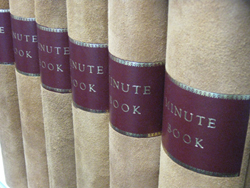
There were ten workhouses in county Galway. Those at Ballinasloe, Clifden, Galway, Gort, Loughrea, and Tuam were established in the 1840s. The Unions at Glenamaddy, Mountbellew, Oughterard and Portumna were established in 1852.
Galway County Council Archives holds some archives, mainly Board of Guardian minutes, from all Unions except Oughterard and only one item for Portumna Union.
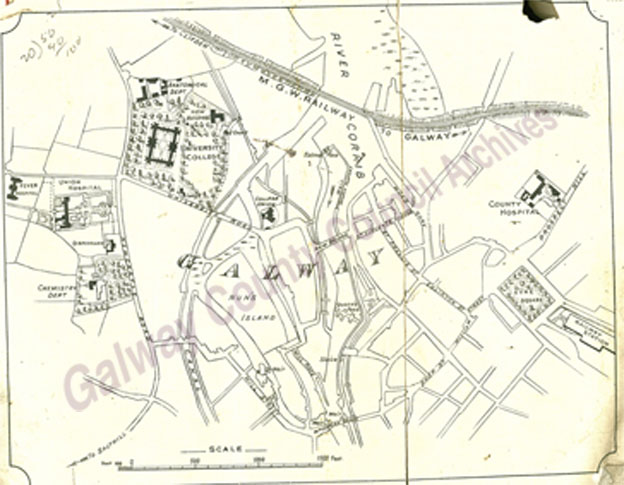
Map of Galway City, circa 1900, showing location of the Workhouse and County Hospital
- G00/5 Ballinasloe Poor Law Union 1842-1931
- Clifden Poor Law Union GPL3/, 1849 – 1921
- Galway Poor Law Union, 1839 - 1937
- GPL1 Glenamaddy Poor Law Union 1894-1913, 2 volumes only
- Loughrea Poor Law Union, 1839 – 1922
- GPL4/ Mountbellew Poor Law Union, 1850 –1921 (1st 10 volumes)
Mountbellew Girls A Tale of Two Workhouse Emigrants 1852
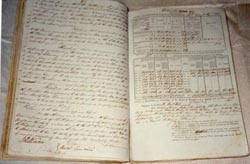
RURAL DISTRICT COUNCILS
Rural District Councils were set up under the Local Government (Ireland) Act of 1898. Their powers were conferred upon them by Sections 2 to 39 of the Act.

The Councils assumed responsibility for the road and public works functions of the Grand Juries where the cost had been borne by the district, and the housing and public health functions of the Boards of Guardians. In the early years of County Councils much of the routine business was transacted through these Councils. The Poor Law Guardians were also the Rural District Councillors; the same individuals but working in a separate capacity.
The Councils played an important administrative role in the period pre-dating the formation of an independent Irish state, and when democratic local government was first established and developing in Ireland. The Councils were dissolved in October 1925 under Section 8, Sub-section (2), (3), and (4) of the Local Government Act of that year. Their functions were transferred, under the Local Government Act of 1925 to the county councils. County councils were in turn required to discharge their new sanitary duties through boards of health and public assistance. These boards also had responsibility for the supervision of county homes, hospitals and dispensaries, housing, water and sewerage, home assistance and a number of schemes including blind welfare, boarded out children, infectious diseases, tuberculosis and the school medical service.
Galway County Council Archives holds the following collections:
- G00-6 Ballinasloe Rural District No.1 Council 1899-1925
- Ballinasloe No.2 Rural District Council, 1917-1919, G00/07
- G01-7 Clifden Rural District Council 1899-1925
- G01-9 Galway Rural District Council 1899-1925
- G01-10 Gort Rural District Council 1899-1924
- G01-8 Loughrea Rural District Council 1900-1925
- G01-6 Mountbellew Rural District Council 1899-1923
-
- G01-11 Tuam Rural District Council 1907-1925
BOARD OF HEALTH AND PUBLIC ASSISTANCE
When the Poor Law was abolished in 1925 the Guardians' remaining functions were transferred to county councils, administered through Boards of Health and Public Assistance.
These Boards were established by County Councils in countries outside of Dublin under the Local Government Act, 1925 to operate as executive committees of the county council to perform health, sanitary and housing functions, assuming responsibility for administering measures against infectious diseases and tuberculosis, sanitary arrangements, labourers’ cottages schemes, water and sewerage schemes and school medical services in small towns and villages. The Boards were abolished in 1942 and their functions taken over by the County Council. The workhouses were replaced by a system of county homes for the old and infirm and hospitals for the sick. Outdoor relief was replaced by home assistance.
- Galway Board of Health & Public Assistance, 1922 – 1941, (GC5/) includes minutes and abstracts of accounts and Home & Home Assistance Committee records.
- GC6 Galway Co. Board of Health & Public Assistance 1922-1942 Minutes
Due to the personal and sensitive content much of the collection has restricted access.
GALWAY HOSPITALS
- Galway Infirmary, GH2, 1802-1892, includes
- Minutes of Governors of the County Infirmary Vol.1 (GH2/1)
- Vol. 3 (GH2/3) including Tenders of Supplies
- Plans & Drawings
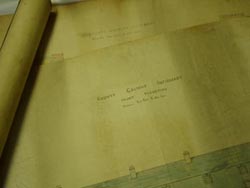
- Galway Hospital, GH1/, 1892-1922 This collection, available on microfilm, includes:-
- Minutes of Board of Management & Nursing Committee
- Financial Statement Books of Receipts
GALWAY COUNTY COUNCIL
The Local Government (Ireland) Act, 1898 formally established county councils. Galway County Council held its first meeting in April 1899.
This is an extensive collection consisting of records for the various sections of the Council, such as Water Services, Environment and Housing. However, the bulk of this material has yet to be processed (cleaned, listed and arranged). As it is the policy of the Archives to only make processed material available to researchers your patience is appreciated, while this slow and painstaking but worthwhile work is undertaken.
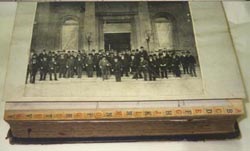
As collections become available they will be added to our on-line catagloue. Some of the records currently available include:
- Galway County Council Minutes, 1899 in continuation, GC/1/
-
Galway County Council, Members Attendance Registers, 1946-1983 (with gaps),GC/2/
-
Bog Expenditure and Turf Haulage Ledgers, 1941-1951, GC3/
- Finance Committee Minutes, 1899 - 1950, GC/3/
- National Monuments Advisory Committee, 1947-1995, GC5/
-
Education Committee Minutes, 1911-1979, GC/6/
-
Staff Attendance Books, 1899-1967, GC/7/
-
General Valuation records, c. 1899-1980, GC/R1/: These contain handwritten entries on a pre-printed form for townlands in each electoral district within the rural districts. Details include townland name, barony, parish and Poor Law Union, and for each property the occupier’s name, name of owners, description of tenement or property, acreage of holding (in acres, roods and perches), and rateable annual valuation.
-
Burial Ground records
-
GC-ENV2 Burial Ground Registers of Interment 1931-2005 (restricted access)
-
GC-ENV1 Burial Registers, Plot books 1882-2005 (restricted access)
- The plot books for Tuam Burial ground are a good genealogical resource, and the detail given under the heading 'Occupation or Rank in Life' is interesting; for instance Servant, Gentleman, Lady, Tailor, Mason, Tinker, Baker, Weaver and Shoemaker are all listed.
Tuam Burial Ground Plot Book, GC/Env1/27, 21 October 1882- 31 December 1902
Tuam Burial Ground Plot Book, GC/Env1/28, 30 December 1902 - 16 February 1920
-
LOUGHREA TOWN COMMISSIONERS
The Commissioners were first established in 1861. However, the minutes are extant only from 1909.
TUAM TOWN COMMISSIONERS
PRIVATE COLLECTIONS
The Archives holds several private collections, including:-
Papers of Tomás Bairéad, GP2 1920-1973: Irish language writer and journalist: The collection consists primarily of press cuttings of reviews and articles (1938-1973) relating to Bairéad’s work, together with letters from friends and colleagues. It also includes rough notes and drafts of his work, together with several photographs, and material relating to his career as a journalist. Available on microfilm.
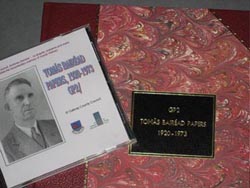
- Blakes of Brooklodge, Ballyglunin, circa 1763-1918, GP5/: accounts, land agreements, and invoices.
-
Papers of the Burkes of Ballydugan, Loughrea, 1707-1970, GP6/: includes marriage settlements and leases, and correspondence primarily between various family members, in particular Michael Burke (1853-1935) and his son William St. Geroge Burke (1902-1963).
-
GP4 Ffrench Papers, Rahasane, Co. Galway 1765-1831 : personnel letters, primarily from female siblings to their brother requesting money due them from various legacies and family trusts; records relating to the care and management of the estate, and the collection of rents and the eviction of tenants; records relating to C. French & Co. Bank at Ormond Quay, Dublin; and to bankruptcy charges and details of items to be auctioned from the estate (1831). Available on microfilm.
-
Kellys of Castlekelly, Ballyglar, 1606 – 1880: Estate papers, such as abstracts of title, rentals, settlements, wills, assignments, letters relating to lands in Ballygar, Killoran, Tully, county Galway and in Strokestown, county Roscommon.
-
Lawrence Papers, Lawrencetown, Co Galway, GP1 1826-1930: Collection of private and business letters, generally dating between the 1870s and 1894, which includes letters between female Wale family members, letters regarding membership of the Free Masons, correspondence with agents and solicitors regarding the heavily mortgaged estate, the payment of interest on loans, the appointment of a Receiver and efforts to secure further loans so as prevent an enforced sale of the estate and material relating to tenants, such as letters from tenants. Also includes Golding (Shrule, Co. Mayo) family letters (1916). Available on microfilm.
- GP8 Minihan Photographic Collection 1890-1980: miscellaneous collection of family photographs. Primarily formal portraits of individuals or couples, also includes several of various priests and also depictions of RIC officers.
- G01-4 Shawe-Taylor, Captain John 1890-1909, Shawe-Taylor (1866-1911), a landlord and British army officer, was an important figure in the Irish Revival movement at the beginning of the 20th century. He was chief instigator of the Irish Land Conference held in Dublin in (1902). The papers comprise of a personal diary (1890) kept when based with the army in the jungles of Burma, and several volumes of press cuttings relating to the Irish Land Conference (1902-1903), the University Question (1903-1904), Irish Reform Association (1903-[1906]), and Irish Industrial Reform (1905-1906, [1909]).
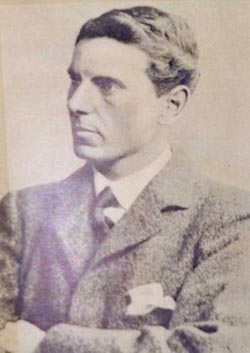
SMALL COLLECTIONS
-
Hardiman, James, Volume of drawings (1814-1830) with captions, of various scenes and objects in Galway city and its environs, several of which were used in Hardiman's ‘History of Galway’ (published in 1820).
- Lawrence, William, of Lisreagh (Belview), Lawrencetown, Family Book and Photograph Album, c.1882, GS01/1: Leather bound album of photographs of portraits of various members of the Lawrence family, the local village, & the interior of and frescoes at Lisreaghan, generally includes biographic detail on the leading family members together with a brief family history, and an account of the geography and history of Lawrencetown. The album is available, in its entirety, on the Ask About Ireland website.
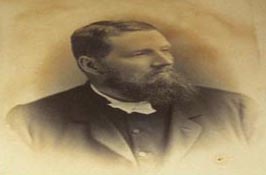
- Loughrea Social & Literary Club, 1892-1895, GS01/8: Handwritten minutes of proceedings of the General and Committee meetings of the Club. Available on microfilm.
- Mansergh, Richard St George, Headford, 1775, 1832, GS01/5: Leather bound gilt-edged volume with maps and descriptions by Charles Frizell of the Mansergh estate at Headford, county Galway; includes rent roll detailing denominations, and tenants and occupiers names.


Find us
on Facebook
Follow us
on Twitter
Gaeilge
agus Fáilte